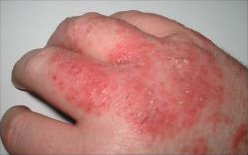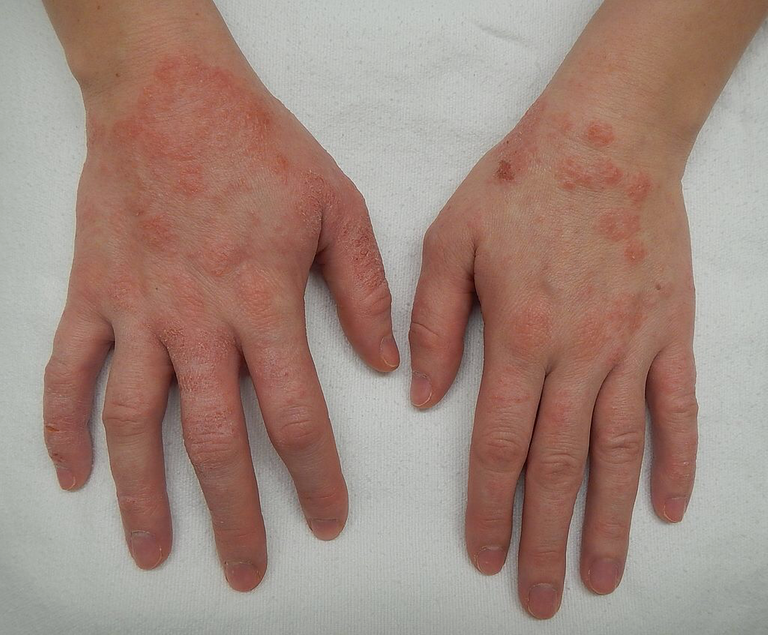The skin is a very important organ in the body, it is the first defense mechanism of the body, it doesn’t only protect the internal organs but also serves as the protective barrier against microorganisms. The skin is the largest organ in the body.

By The original uploader was Topbanana at English Wikipedia. - Transferred from en.wikipedia to Commons by Dcoetzee using CommonsHelper., CC BY-SA 3.0, Wikimedia
Allergies occur when the body’s immune system reacts to a foreign substance. These foreign substances are referred to as allergens. However, they are usually considered harmless to other humans. Allergens are substances that trigger an allergic reaction Examples of such substances include; pollen, rubber, food, metal, animal dander, and insects. In the presence of any of these substances, the body’s immune system produces antibodies (immune defenses) that identify these foreign substances as harmful, the body reacts in a way to get rid of them and this reaction leads to skin diseases.
Skin Allergy is our topic for this week and today, we’ll discuss Atopic Dermatitis as part one for this week.
From the word “dermatitis”, “derm” means “skin” and “itis” means “inflammation.” The word as a whole means “inflammation of the skin.” Eczema was coined from a Greek word “ekzein” meaning to “boil over” or “break out.”
Atopic Dermatitis (also called Ezcema) is the inflammation of the skin. It is a condition that causes the skin to become dry, red, itchy, and bumpy. Eczema damages the skin barrier function which makes the skin more sensitive and prone to infection and dryness.
Eczema is a very common disease in the world, especially in Africa. It is a noncontagious disease that affects mostly children.
CAUSES OF ATOPIC DERMATITIS
Atopic dermatitis is caused by a combination of:
Immune system activation
Genetics
Environmental triggers
Stress.
Immune system
Overreaction of the skin to an allergen can lead to inflammation of the skin.
Genetics
An individual is likely to have eczema if there is a history of dermatitis in the family. There is also a higher risk if there’s a history of asthma, hay fever, or other allergy-related diseases.
Environment
There are a lot of in the environment that can trigger skin reactions. Some examples include dust, smoke, air pollutants, harsh soaps, fabrics such as wool, and some skin products. Low humidity (dry air) can cause the skin to become dry and itchy. Heat and high humidity can cause sweating and that can make the itchiness even worse.
Stress
Stress is generally a trigger for a lot of diseases. An individual’s stress levels can cause or worsen eczema by increasing body reaction.
SIGNS AND SYMPTOMS OF ATOPIC DERMATITIS
Some signs and symptoms commonly associated with atopic dermatitis include;
- Dry skin.
- Itchy skin.
- Red rashes.
- Bumps on the skin.
- Scaly, leathery patches of skin.
- Crusting skin.
- Swelling.
INCIDENCE
Infants are more prone to eczema and 10% to 20% will have it. Though nearly half outgrow the condition or have significant improvement as they get older. It affects males and females equally and is more common in people who have a family history of allergic diseases.

By James Heilman, MD - Own work, CC BY-SA 4.0, Wikimedia
CLINICAL MANIFESTATIONS OF ATOPIC DERMATITIS
Most times the signs and symptoms vary in infants, children, and adults.
Symptoms In Adults Can Include
- Dry skin.
- Itching, especially at night.
- Red or Brownish colored patches, especially on the hands, feet, ankles, wrists, neck, upper chest, eyelids, inside the bend of the elbows and knees.
- Swelling
- Bumps
- Cracked or thickened skin
Symptoms in infants (0-1years old) can include:
- Dry, itchy, scaly skin.
- Affects mostly the scalp or cheeks.
- Rash may contain fluid.
Infants with these symptoms may have trouble sleeping at night.
Symptoms in children can include:
- A rash in the creases of the elbows, knees, or both.
- Scaly patches on the skin.
- Dry and scaly skin.
- Affects mostly the neck and face, especially around the eyes.
DIAGNOSTIC INVESTIGATION
Atopic dermatitis is usually diagnosed by physical examination. In some cases, a skin patch test is done where different substances (up to 20-30) that can cause atopic dermatitis are exposed to the skin. The test is done to identify the particular allergen responsible for allergic reactions and also to rule out other skin diseases.
Medical Management of Atopic Dermatitis
- Antihistamines such as diphenhydramine (Benadryl) can be taken to reduce inflammatory response by blocking the effect of histamine.
- Topical corticosteroids are used to prevent inflammation.
- low doses of cyclosporine, an immunosuppressive agent, can also be taken.
SOME WAYS TO COPE WITH ATOPIC DERMATITIS
- Bath at least twice a day.
- Allow moisturizer to get absorbed by the skin before getting dressed.
- Avoid prolonged exposure to sunlight.
- Avoid scratching the affected area, rather patting the skin is advised.
- Keep nails trimmed.
- Avoid using harsh skin products.
- Avoid wearing skin-tight, rough texture cloth.
- Avoid strenuous activities.
In summary, Atopic Dermatitis is a common disease, It can occur in all individuals, especially children and young adults. It can be treated medically but when caused due to genetics, coping with it might be the only solution. However, Avoidance therapy is the best way to deal with atopic dermatitis especially when allergens have been identified. Thank you.
For References and Further reading:
Skin conditions are usually causes of worry to those who have it, especially in the areas of cosmesis. But reassurance and proper management is always relieving.
Nice one dear. That's great👍
Well said👏
Thank you dear
Thanks for your contribution to the STEMsocial community. Feel free to join us on discord to get to know the rest of us!
Please consider delegating to the @stemsocial account (85% of the curation rewards are returned).
You may also include @stemsocial as a beneficiary of the rewards of this post to get a stronger support.
Thank you stemsocial❤️